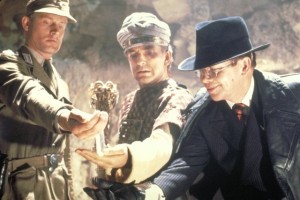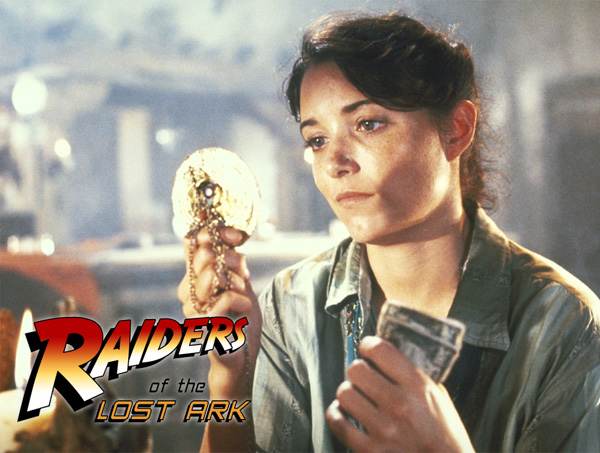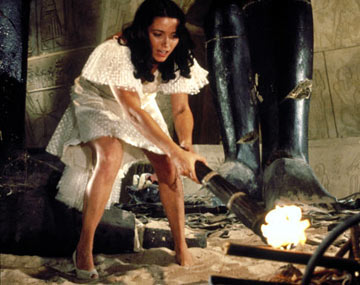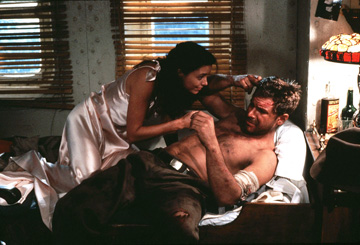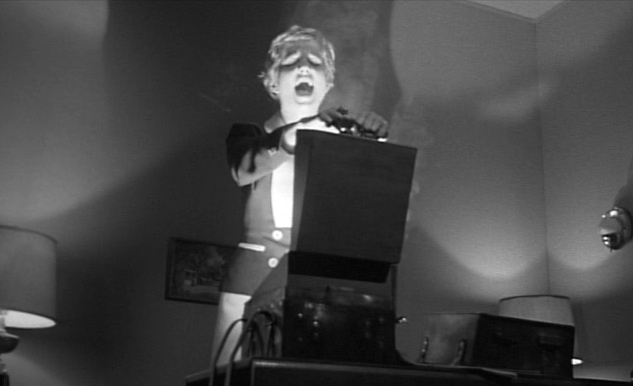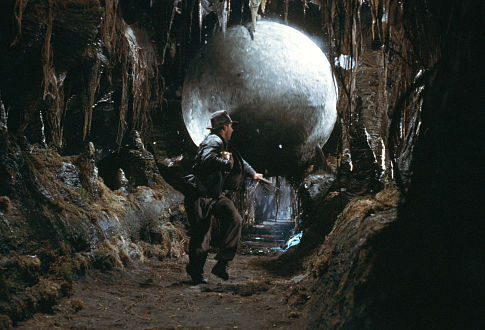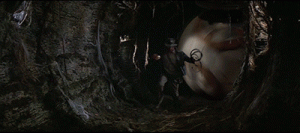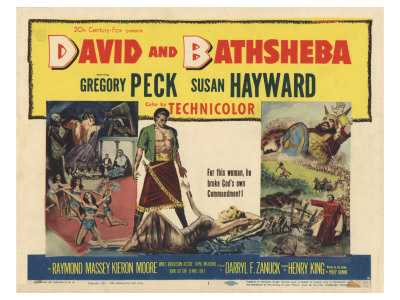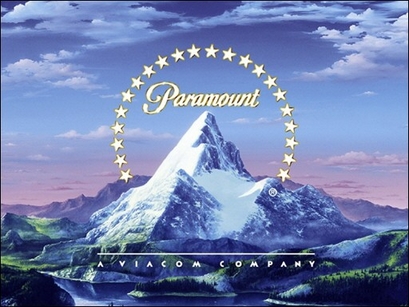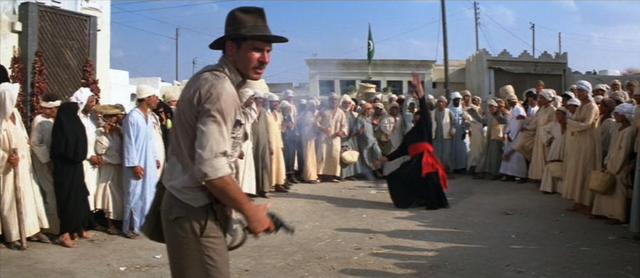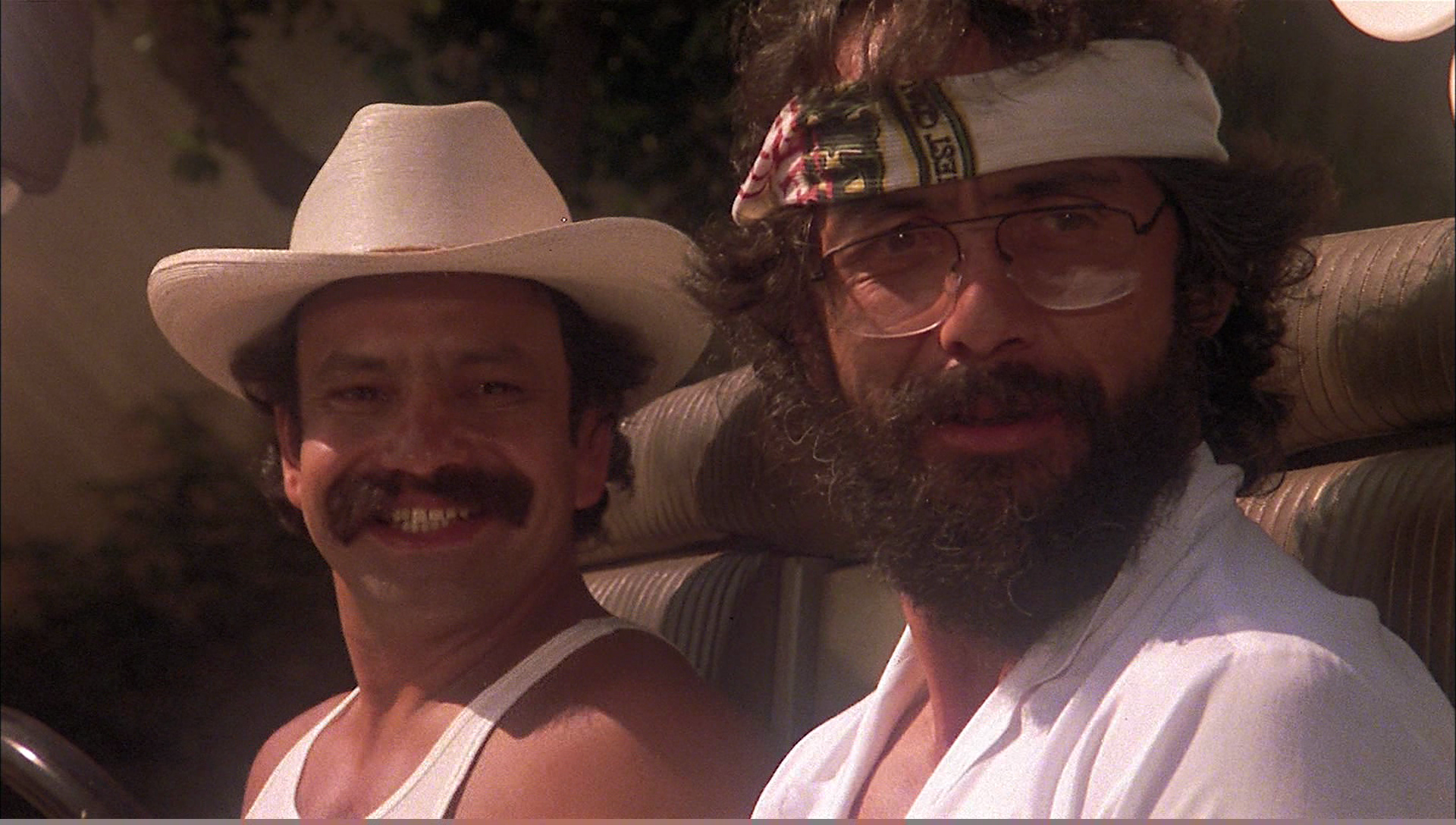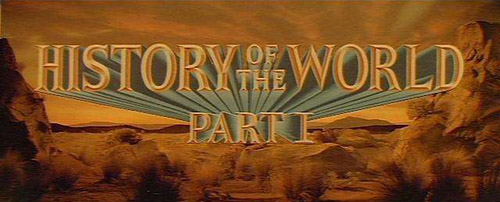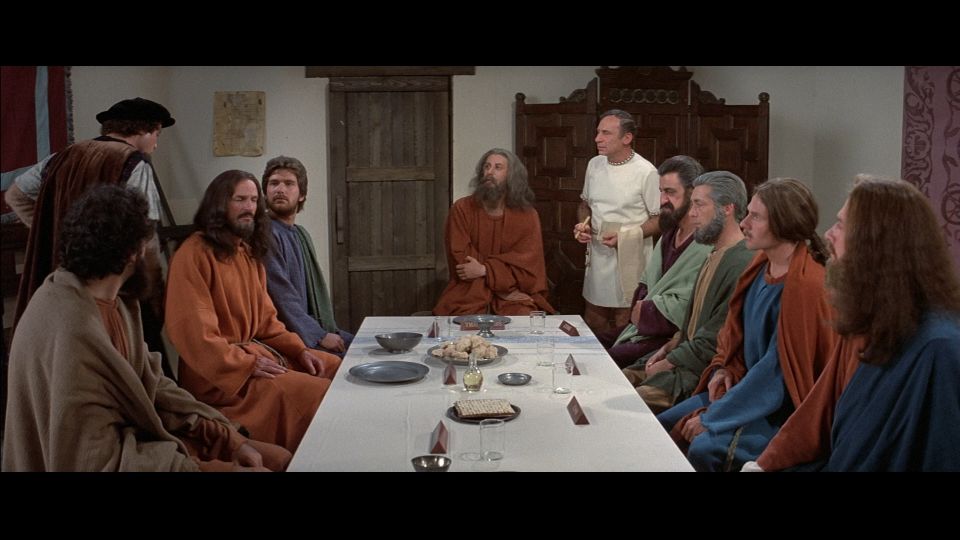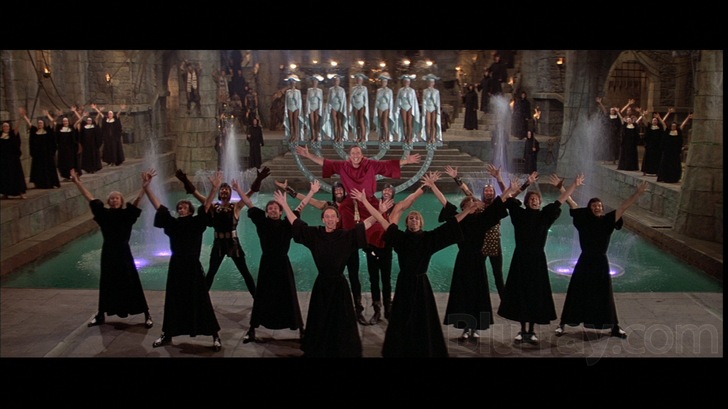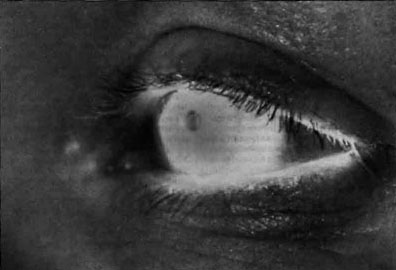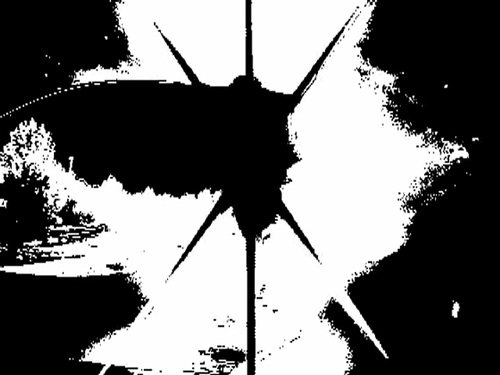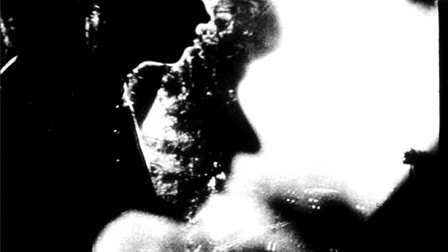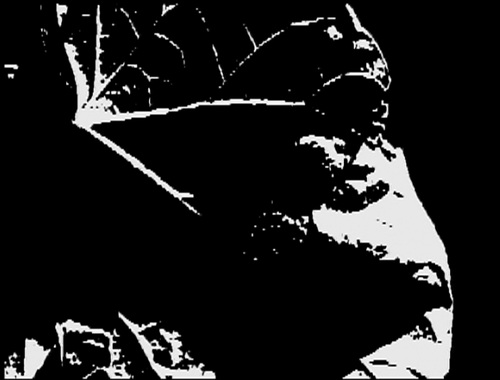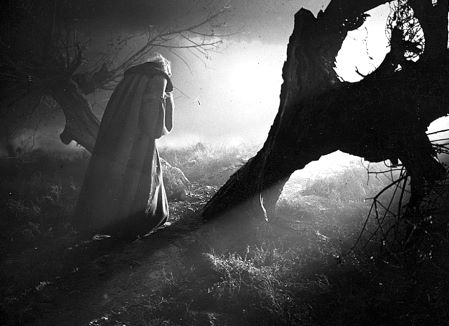From The Soho News (June 10, 1981). I posted the first part of this, on Raiders of the Lost Ark, some time ago, but this, belatedly, is the full column — and, in my opinion, the best of my “Declarations of Independents” columns for The Soho News. (I believe there were ten of these in all.) Note: The film stills from Of Light and Texture are copyrighted by the Estate of Andrew Noren. — J.R.
Raiders of the Lost Ark
Cheech & Chong’s Nice Dreams
History of the World, Part I
Of Light and Texture (Museum of Modern Art)
As the most gifted and congenial by far of all the New Hollywood tyros, Steven Spielberg may be the only consummate master of the post-TV movie spectacular — the blockbuster that’s diced out into bite-size narrative units like Chicken McNuggets (every structural hint of bone or body part processed out of existence, every juicy piece a separate unique experience, designed to vanish without a trace). Aspiring to the condition of continuous action as if that were a delirious state of grace — borne aloft by superbly timed jolts and impossibly narrow escapes, usually in three to five-minute setpiece doses — Raiders of the Lost Ark (rated PG for pretty good) all but bypasses character and logic for a string of stunning rides through Disneyland, one right after the other, each one a visceral treat.
Valuing speed over sense, the movie is too energetically rushed to allow itself any detours into lyricism. It’s a surprising turn of events for the director of Close Encounters of the Third Kind, but the boxoffice blues of 1941 (which I would dearly love to see again) must have led Spielberg to some second thoughts about how to bring an audience to its knees — back to the lessons of Jaws, in other words, with the additional commercial support of George Lucas (who produced and collaborated with Philip Kaufman on the original story).Consequently, even when God puts in an appearance toward the end of this globetrotting adventure –a fiery, vengeful Old Testament God playing yang to the yin of the benign aliens in Close Encounters — He doesn’t get to stick around any longer than a commercial.
I’ll never forget the queasy experience I had one Sunday afternoon last year, in the front row of a crowded midtown theater, watching the grisly elevator murder in Dressed to Kill at the same time that the man who created it, Brian De Palma, was a couple of seats away, watching me and others react to it (and leaving the theater as soon as the experience was over).The curious thing about his gaze, as I recall it, was that it conveyed a lot of pride and satisfaction, yet none of it was directed at the screen.
It’s a gaze I recalled more than once while responding in a similarly helpless way to the merciless mechanics of Raiders of the Lost Ark — and not merely because Spielberg and Lucas are also decadent disciples of Hitchcockian storyboard construction in which The Sequence becomes the whole raison d’être of filmmaking. It was also related to the dawning realization that the real continuity and characters of their movies can be truly located only in their audience responses — not in any autonomous evidence up on the screen, which is bound to be relatively uneven and riddled with gaps (e.g., how does the hero get to the Mediterranean island on a Nazi submarine?
Consider Karen Allen here, a likable, resourceful actress who gets used like one of those convertible stage units in a play full of short scenes. First she’s established (in a drinking bout) as one of the boys, then as some perfunctory variant of the mannish woman (Joan Crawford as Vienna in Johnny Guitar) running a Nepalese saloon, then as a fluttery sort of captive heroine who clearly isn’t one of the boys, then as a background prop; whatever a given scene requires, she dutifully becomes. The same principle holds (more or less) for everyone and everything else in the movie, from hero Indiana Jones (Harrison Ford) to villain Belloq (Paul Freeman) to the Ark of the Covenant to somebody’s pet monkey. Try to summon up a composite image anywhere, a feeling or idea that you can salvage when the movie’s over, and you’re mainly stuck with an arsenal of disconnected poses and disposable functions.
There’s a lot of confusion around — most of it to the advantage of banks — about the status of this blunderbuss approach to art. Its effectiveness as dazzling entertainment is hard to quarrel with; I was glued to my seat, and even the monotonous lack of variation in the pacing (as in 1941) has something soothing about it. But the creepy presumption of most criticism nowadays is not only that it’s possible to be a Serious Artist while wielding mega-bucks, but that it’s often necessary to wield those lofty budgets in order to be considered “seriously” at all. Around the time of the release of Star Wars, it was widely reported that Lucas intended to make only avant-garde films in the future. Such a story seemed preposterous then, and I find it even harder to swallow it now. Lucas lacks the freedom to make avant-garde films — assuming that freedom is ultimately a matter of mental space more than budget. Most people, I know, assume the reverse of this — such is the myth that keeps those industry wheels turning — but few highly budgeted directors have ever seemed like exceptionally free individuals to me.
So maybe the real auteur of Raiders of the Lost Ark is neither Spielberg nor Lucas — however brilliant each may be in his separate functions — but the money that plays with them and us, the money that calls all the shots. Combining the dogged desire of Lucas to be pulpier than Sax Rohmer in this 1936 white supremacist archeological romp (while combining all the world’s most important religious myths of the head of a pin and simultaneously whistling Dixie) with the mystical awe and propulsive storytelling of Spielberg, the movie has a certain economic relation to art, like 1941, that might be called Teenager’s Revenge.
How deeply are we expected to get involved in a plot about the fabled Ark of the Covenant which doesn’t feature a single Jew, with “Arab” (i.e., proto-Iranian) and Nazi villains gallore? Raiders somehow contrives to convert the Great Whatsit of Kiss Me, Deadly (nuclear deaths in Pandora’s Box) into the 10 Commandments of Cecil B. De Mille without ever convincing us that either has the moral weight of Cheech & Chong’s roach clip, or the 15 Commandments of Mel Brooks (see below). It mainly locates its few tokens of crunchy transcendence in its audience’s unconscious and its promo campaign. On the screen, it sticks more practically and nihilistically to the short-range task of being a “rattling good yarn” — one, indeed, that rattles and hisses at you in sensuous Dolby while boldly slinging you from one outrageously suspenseful snake pit to another. Before the movie’s scarcely begun, Indiana Jones is being chased by a giant bowling ball through a Peruvian cave that’s otherwise characterized by tarantulas, treasures, diverse death-traps and cave-ins.
“I am a shadow reflection of you,” Freeman says coolly to Ford at one point, alerting those academics who might want to brood seriously over this enjoyable nonsense. The Ark itself is a McGuffin-prop lifted from David and Bathsheba, a Gregory Peck vehicle of 30 summers ago. As I see it, the Great Whatsit here is really nothing more than the Proverbial Magic of Movies — the only subject Spielberg/Lucas seem equipped to tackle head-on, in tandem with the usual dull concentration on the nature of power trips (which is what turned Apocalypse Now from a film about Vietnam into a film about being a director, and what makes the last shot of Raiders a clear steal from Citizen Kane.)
In a way, the opening dissolve from the Paramount logo to the to an actual mountain peak tells us all we need to know. By the time we arrive at the climactic narrative striptease on a mountaintop, we see death pour out of the Ark like a lethal dose of projector light, spilling out hologram-like figures which emerge from the emulsion only to turn ugly and start zapping the Nazis dead. Faces melt fabulously (in the snazziest of all the flashy special effects) as the Nazis are being cremated; the heavens part to suck up all the cinders and then neatly close shut again, like a zipper.
But the most thrilling moment of sexual release for the audience I saw Raiders with was the humorously delayed decision of Jones, much earlier, to shoot a fancy sword-swishing Arab with his gun rather than worry about using his whip. Its offhand genocidal message comes very close to being the only one that New Hollywood (from Taxi Driver to Star Wars to Apocalypse Now to Dressed to Kill) can find beyond its pretty, bejeweled navel — a pithy suggestion, derived from Conrad’s Kurtz in Heart of Darkness, that simply says, “Exterminate the brutes.”
***
I mean, like being looked at and doing the looking aren’t always that separate as activities, especially if you’re stoned. So surveillance in Cheech & Chong’s Nice Dreams — often conducted from the epic vantage point of police helicopters that are higher than kites — has a nice cutting edge that allows you to do it, magisterially, as well as feel paranoid about having it done to you. Just as the spaced-out police sarge (Stacey Keach) gradually turns into some kinna slimy awful lizard reptile ooze from sucking a see-through bong on all the loco weed that his station boys filch off unsuspecting heads, Cheech & Chong — two wild and crazy guys, sloppy humanists both — allow you to step in on either side of the pot dialectic (Nice Dreams is rated R, for Reagan), take a shower and get down to serious business, man, if you know what I mean. There are also a couple of coke and acid gags; a nice, silly song by Cheech about saving the whales and shooting the seals; and even a slightly hallucinogenic, sparkler-burning Statue of Liberty in the opening Columbia Pictures logo.
It took me most of the movie to figure out who was Cheech (Richard Marin, who co-scripted) and who was Chong (Thomas Chong, who co-scripted and directed); I saw their Up in Smoke (directed by Lou Adler) back in the fall of ’78, but you know what grass can do to short-circuit memory, make it all go up in whatchamacallit. Anyway, if faulty memory serves, this one is even funnier, also possibly more dumb — either despite or maybe just because of its never getting beyond the Simple Simon deconstructiveness of an old Bing ‘n’ Bob Road comedy. (Neither, for that matter, does the next film in this column. So what else is new?) In a Chinese restaurant, Evelyn Guerrero turns up to play an entertainingly goofy variation of Dorothy Lamour. Later she proposes a sexual threesome with the star High-Cs, until her convict husband, Animal, wearing a patch that says “Give me head ’til I’m dead,” comes home; you can guess the rest, and so can C&C.

***
In spite of a vulgar reputation for being more “physical” and less “cerebral” than Woody Allen, Mel Brooks is conceivably the most literary Jewish comic filmmaker that we have — reminding us at every turn to what degree Judaism is an oral/verbal as opposed to visual culture. When someone in ancient Rome remarks, “The streets are crawling with soldiers,” you know in advance that Brooks will have to follow this with a non- sequitur visual equivalent, just as Tex Avery used to do in his daffy cartoons about slang — giving the word and voice primacy, literally making it flesh by spelling it out in rebus form.
“Death was greeted with a certain amount of awe,” intones narrator Orson Welles near the start of Brooks’ History of the World, Part I, and everyone standing around in the perfunctory, instantly forgettable shot who isn’t supposed to be a corpse goes, “Awwwww — .” “The only thing we don’t have a god for yet is premature ejaculation,” Brooks rattles on frantically, standup-philosopher style, to Dom DeLuise’s hysterically Juicy Fruit Emperor Nero in (you guessed it) Caesar’s Palace, “and that’s coming quickly.” Saying as well as spraying it, chewing and spewing words until they overspill and start to fill in some of the cracks left by the illustrative images, Brooks is a food as well as word man, and logically enough includes among his several roles in this movie the waiter that breaks into The Last Supper to inquire, “Does everybody want soup?” He arrives, incidentally, just before Leonardo turns up for the portrait and gets everyone to pose on the same side of the table — a neat ellipsis that has to stand in for Brooks’ depiction of the Renaissance. (The reason, according to Brooks, why we have 10 commandments instead of 15 is that Moses dropped one of the three original tablets.)
To be fair, History of the World, Part I, in spite of its title, has a pretty modest aim. It merely seeks to be another cheerful Mel Brooks film, one more bubbly Borscht-circuit surrealist boogie. (When Brooks served as producer on The Elephant Man, he was further exploring his literary bent in a way — following the cozy, genteel, armchair manner of gents like Val Lewton or Albert Lewin in packaging the painterly goods of a David Lynch.) The movie tends to get a little lost and choppy whenever it has to go for long without continuous characters and consecutive plot, and, like many a stage revue, generally becomes a meditation on show biz itself whenever it expands beyond the confines of an isolated blackout gag. (At its workaday worst, it gropes blindly after every chestnut in sight; by now, I find 2001 parodies about as tiresome as Rosebud and Casablanca jokes.) For my money, a gala production number celebrating the Spanish Inquisition improves appreciably on the “Springtime for Hitler” number in The Producers as an inspired amalgam of the best and worst that show biz can offer (and process), all in one brassy package.
The best parts, like the above, all reek of the stage — perhaps another reason why the words tend to predominate, and to take flight from the dull Panavision frames that seek to cage them like winged creatures. “Don’t be saucy with me, Bearnaise,” somebody chides during the French Revolution, and the only “miracle” that can save Brooks from the guillotine is a horse with that name. It’s no wonder that The End in this movie is carved into the side of a mountain that Miracle rides past.
***
Of Light and Texture, an exhibition of films by Andrew Noren (June 11 and 15) and James Herbert (June 16 and 23) at the Museum of Modern Art, offers a filmgoing experience at once so much more intense and diffuse that Spielberg, Brooks, or Cheech & Chong that I can recommend it to a few of you out there as the perfect alternative to standing in line for the amusement park rides described above. Judging from the samples I caught at a press show, there aren’t any (or many) laughs to be had, but there are certainly thrills galore, at least of a particular kind I would call contemplative or meditative (as opposed to conquistatorial or dictatorial) — the kind of space that a cool museum and a quiet afternoon can afford you, and the above movies cannot. For starters, all the films in this program (with the exception of Herbert’s six-minute Pluto, on the 16th and 20th) are silent, allowing you to let yourself think and hear yourself breathe.
“Do these movies go anywhere?” I can hear my more linear-minded and plodding, plot-ridden friends asking, stuck with the necessity of segregating their art from their lives and politics. The answer is yes, they do — deeper and deeper into the substance of light and texture, which of course is something that affects all our daily visual experience, a subject that spreads out over our lives as blandly, as completely, and, most of the time, as unmemorably as a picnic tablecloth over a patch of ground. On the other hand, if you’re convinced that the forgetfulness of narrative — like the forgetfulness of journalism, a similarly self-contained cultural activity — is always better than the remembrance of experience, I’d suggest that you stay away.
We each have our own means of entry (or non-entry) into subjects like light and texture. Mine was the first film I saw in the MOMA series — Andrew Noren’s feature-length Charmed Particles (1977), Part IV of his ongoing The Adventures of the Exquisite Corpse, which you can see on the 11th and 15th — an experience that regrettably wasted me in relation to Herbert’s Porch Glider (1970) and January (1973), shown just afterward at the press show. (The same thing won’t happen to you at MOMA, where the filmmakers are allotted separate programs.) So black and white that it made me forget that color films existed, and so sensually rich that it made me want to go on a movie diet (just my luck: I had to see the Brooks film, with its low-cal visuals and deep-fried verbals, less than three hours later), this exquisite chronicling of Noren’s self-confessed activity as a “light thief” and “shadow bandit,” mainly within the limited (yet limitless) confines of a small city apartment, create a visual music so concentrated and uninterrupted (George Lucas, eat your heart out) that I’m sure any musical accompaniment would be redundant, or, even worse, reductive in effect.
Mottled shadows flicker across an eye, a horizontal wipe reveals clothes swaying on a line (like a glissando running up a keyboard), silvery light speckles a floor or atomizes on quivering water, wind blows snow crystals at night, fragments of fabric drift past an open window (in a peekaboo pattern remaining a basic rhythmic component throughout, a perpetual give-and-take of now you see it/now you don’t), parts of human and feline bodies and diverse objects conspire in activities (walking, dishwashing, reading the paper, looking at a TV or a movie still).
Often evoking the luminous textures of certain European films in the 20s (like the pulsating light patterns of Faust), as well as the pantheism and “poetic structuralism” of a filmmaker like Louis Hock — with smoke, hair, leafy textures and fabrics treated as delicately as brush-strokes, then mixed together in a sort of blender that suggests Josef von Sternberg’s teasing manner of dissolving his own bric-a-brac — Charmed Particles can the lead the spectator into many possible directions. You might even want to take it with you to a desert island, like Manhattan in June.


